Spacing guidebook
The Forest and Range Practices Act and its regulations took effect on Jan. 31, 2004. It replaced the Forest Practices Code of British Columbia Act and regulations. Forest Practices Code guidance is presented for information purposes only.
The guidance offered here is still relevant with regard to field practice.
Introduction
Purpose
This guidebook is intended to assist forestry practitioners to meet the requirements of the Forest Practices Code with respect to spacing. Guidelines are enclosed in text boxes throughout this guidebook. Guidelines cover stand ranking and selection criteria, methods of spacing, fire protection considerations, the maintainence of biodiversity, and post-treatment stand densities. Spacing is also known as juvenile spacing or pre-commercial thinning.
For further information on the subjects addressed in this guide refer to the references listed in Appendix 2 or contact the B.C. Ministry of Forests.
Impacts of spacing
Spacing is the cutting of undesirable trees within a young stand to reduce competition among the residual trees for water, nutrients, and sunlight. The cut trees are usually not removed from the site. Spacing is done to:
- control density to meet tree growth objectives
- meet biodiversity and wildlife habitat resource objectives
- maintain or enhance forest health
- manage species composition and stand structure
- increase stand value.
Typically the effects of reducing stand density are:
- an increase in growth of residual trees
- an increase in juvenile wood production and an increase in average knot size
- a reduction in the length of financial and technical rotations and an increase in rotations based on the culmination of mean annual increment
- avoidance of height-growth repression that can occur in high density stands growing on poor sites.
Authority
-Spacing: pre-free growing
"Stocking requirements" means
(a) for clearcutting, patch cutting and group selection, group shelterwood, group seed tree, and clearcutting with group reserves,
(i) the preferred and acceptable species of trees,
(ii) the minimum allowable horizontal distance between trees of the preferred and acceptable species required for the trees to be considered to be well spaced,
(iii) the target number of healthy, well spaced trees of the preferred and acceptable species per hectare,
(iv) the minimum number of healthy, well spaced trees of the preferred and acceptable species required per hectare,
(v) the minimum number of healthy, well spaced trees of the preferred species required per hectare,
(vi) the maximum number of coniferous trees allowed per hectare,
(vii) the maximum and minimum number of healthy, well spaced coniferous trees allowed per hectare after a spacing treatment has been carried out under section 70 (4) (f) of the Act, and
(viii) the required standards that must be met by a healthy, well spaced tree of a preferred or acceptable species at free growing, including
(A) the minimum height,
(B) the height of the tree relative to competing vegetation within a radius of one metre of the tree trunk, and
(C) any other similar requirements imposed by the district manager,
(b) for even-aged partial cutting not described in paragraph (a),
(i) all of the requirements referred to in paragraph (a), and
(ii) the stand structure and composition goals, including the planned residual basal area or density per hectare, or
(c) for single tree selection, for
(i) all layers, the preferred and acceptable species of trees,
(ii) the regeneration, sapling and pole layers, the minimum allowable horizontal distance between trees of the preferred and acceptable species required for the trees to be considered to be well spaced,
(iii) all layers, the target number of healthy and well spaced trees of the preferred and acceptable species per hectare,
(iv) all layers, the minimum number of healthy, well spaced trees of the preferred species required per hectare,
(v) all layers, the minimum number of healthy, well spaced trees of the preferred species required per hectare,
(vi) the sapling layer, the maximum number of coniferous trees allowed per hectare,
(vii) the sapling layer, the maximum and minimum number of healthy, well spaced coniferous trees allowed per hectare after a spacing treatment has been carried out under section 70(4)(f) of the Act,
(viii) the planned residual basal area per hectare, the number of trees by each diameter classes on the area, and
(ix) the required standards that must be met by a healthy, well spaced tree of a preferred or acceptable species at free growing, including
(A) the minimum height for the regeneration layer,
(B) the height of the tree relative to competing vegetation within a radius of one metre of the tree trunk for the regeneration layer and the sapling layer, and
(C) any other similar requirements for all layers imposed by the district manager.
-Spacing: post-free growing areas
Scope of the stand management prescriptions
A person preparing a stand management prescription must, for the area under the prescription
(a) consider the result of any free growing survey carried out on the area,
(b) ensure that the prescription is adequate to achieve the future stand condition specified in the prescription,
(d) ensure that the prescription is adequate to achieve continued growth of species that are ecologically suited
for the area,
(e) ensure that the prescription facilitates the protection of the soil on the area, and
(f) describe any actions required to achieve known landscape level objectives for stand structure and species composition.
-Content of stand management prescriptions
(1) A person preparing a stand management prescription must, for the area under the prescription, ensure that the prescription
(h) If mechanized stand tending treatments are proposed in the stand management prescription, it must then describe
(i) the treatment season
(ii) method of treatment
(iii) the site sensitivity to soil disturbance, and
(iv) the maximum proportion of the area that may be occupied by soil disturbance,
(i) sets out the actions that are proposed to abate fire hazards
(k) sets out the target future stand condition and proposed treatments, including spacing, pruning and fertilizing and the objectives of those values.
For further information on stand management prescriptions (SMP) refer to the Stand Management Prescription Guidebook.
Spacing and commercial thinning
(1) A person must ensure that sufficient trees remain standing and undamaged to meet the resource management objectives for the area specified in any higher-level plans, if the person carries out
(a) a spacing treatment under a stand management prescription,
(b) a spacing treatment under section 70(4) (f) of the Act, or
(c) a commercial thinning treatment under a silviculture prescription.
(2) Unless otherwise provided in a higher-level plan or a forest development plan, a person who carries out a treatment under subsection (1) (a) or (b) must not fell a tree that
(a) is ecologically suitable for the area based on the biogeoclimatic ecosystem classification specified in the prescription, and
(b) is not a significant competitor with a tree designated as a final crop tree.
Reports
Obligation of major licence holder (Silviculture Prescription)
A holder of a major licence who is required to establish a free growing stand on an area under a silviculture prescription must submit each year to the district manager the following reports:
(c) on April 15, July 31, October 31 and January 15, a report in Form B describing the silviculture activities completed in the harvest area as of the date 2 weeks before the submission date;
(e) on May 15, a report in Form D describing silviculture expenditures during the preceding year ending March 31.
Obligation of woodlot licence holder (Silviculture Prescription)
A holder of a woodlot licence must submit to the district manager, on or before April 30 each year, an annual report in the form required by the chief forester, describing silviculture treatments and timber harvesting activities completed, and results achieved, under the approved silviculture prescription for the previous calendar year.
Obligation of the government (Silviculture Prescription)
(1) If the government is required to establish a free growing stand
(a) the district manager must
(i) keep accurate records of silviculture treatments, and
(ii) beginning in 1996, on or before April 30 each year submit a compliance report for the preceding year ending March 31 to the regional manager, and\\
(b) beginning in 1996, the regional manager must on or before May 31 each year submit a compliance report to the chief forester.
Obligation of major license holder under stand management prescription
(1) A holder of a major license who carries out a silviculture treatment specified in a stand management prescription must prepare a report that
(a) contains a summary of the silviculture treatments performed on the free growing stand on the area during the period beginning 2 weeks before the last report and ending 2 weeks before the current report’s submission date under subsection (2), and
(b) specifies whether the silviculture treatment was carried out to fulfill the requirements of a management plan or an agreement under the Forest Act.
(2) A person required to prepare a report under subsection (1) must ensure that the report
(a) is signed and sealed by a professional forester, and
(b) is submitted each year to the district manager on April 15, July 31, October 31 and January 15.
(3) The chief forester may specify the form and content of a report under subsection (1)
Spacing required by silviculture prescription
Maximum density
A maximum density number must be specified in each silviculture prescription for stands denuded:
- post October 1, 1987 for lodgepole pine and dry belt Douglas-fir
- post April 1, 1994 for all coniferous stands.
Conifer stands with densities above the maximum density specified in the silviculture prescription, must be spaced. After spacing, the final density of healthy well-spaced coniferous trees must be within a maximum and minimum number of trees stated in the silviculture prescription. A stand is not free growing until its maximum density obligations are met.
Stand regeneration and spacing are the two management techniques that most significantly impact stand development. Regeneration and spacing manage stand density. Changes to stand density affects, among other things, tree diameter, stem volume, stand volume, and amount of shrubs and forbes. Density management is therefore the most significant means of shaping a desired future forest.
In timber supply analyses, managed stand yield curves are used to project stand densities and their resultant merchantable volume and piece sizes. If stand densities are not managed to these levels, forest level objectives may not be achieved within planned time periods.
The main objective of the maximum density requirement is therefore to ensure that stand densities are controlled, through early regeneration practices or spacing, so that minimum tree size, merchantable volume, and management objectives are achieved within an acceptable period of time.
The maximum density requirement allocates some of the costs and responsibilities for density management to licensees with silviculture prescriptions who are harvesting valuable stands today. In B.C., about 25 per cent of the regenerated areas come back to more than 5000 stems per hectare (sph), the usual number of countable stems to trigger maximum density spacing.
Stands that do not exceed prescribed maximum densities may be spaced, using other sources of funding, after the site has been declared free growing. Any spacing planned on free growing areas should be detailed in a stand management prescription.
Maximum density has nothing to do with repression densities or excessive densities that may reduce the potential site index or productivity of a stand. Repression is currently thought to occur when lodgepole pine stands densities exceed 10 000 sph.
Planning for maximum density
The Establishment to Free Growing Guidebook lists targets and minimum stocking standards based on ecosystems and species. These stocking standards are a starting point for density planning. The guidebook stocking standards provide numbers suitable for many stands. However, under optimal planning, these stocking standard numbers would be modified as necessary to meet specific stand objectives. A stand planned for multiple commercial thinning entries should have more stems left. A stand with forage creation as an objective may have significantly fewer stems. Forest health factors, recognized at the pre-harvest stage can also require modification of the guidebook stocking standards.
Maximum density spacing is required when a survey of countable stems (see section on countable stems) indicates greater than the maximum number of countable stems per hectare exist on an obligation area. The stand must then be spaced down to between a minimum and maximum post-spacing density of well-spaced trees. In most cases, the post-spacing densities should be identical to the establishment target and minimum stocking standards for a particular silviculture prescription. The common theme is that, by free growing, the stand should be within a pre-specified density range in order to meet required stand objectives. Whether this stand level objective is met by regeneration techniques or by spacing techniques should not greatly impact the density range required.
The following example taken from (Table Interpolation Program for Stand Yields, Windows version 1.0) shows the minimal differences in two good site pine stands, one naturally regenerating to 5555 sph and spaced to 1200 sph and the other being planted to 1300 sph with no ingress.

The target stocking standard and the maximum post-spacing density can differ if there are clear reasons. These numbers still have to be written in the silviculture prescription. An example of this would be if porcupine feeding damage is a possibility in the area. A spacing operation may need to leave extra stems in the form of "sacrifice trees" to compensate for the feeding damage (see Pests of Young Stands Guidebook). The Operational Planning Regulation mandates the specification of these stocking and density standards within a silviculture prescription (see Figure 1).
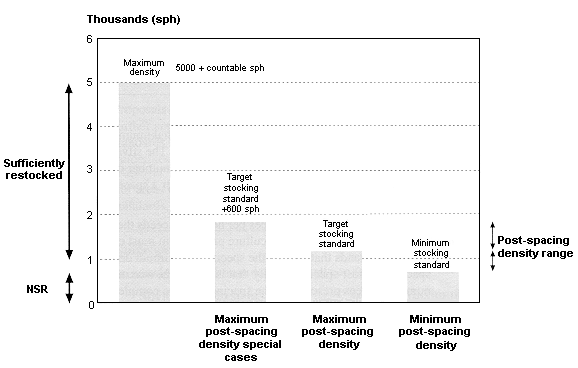
They include the following:
- Target stocking standard – is the target number of healthy well-spaced trees of preferred and acceptable species per hectare desired on the area. This is the target number of well-spaced trees at the free growing stage that will produce the target future forest conditions.
- Minimum stocking standard – is the minimum number of healthy, well-spaced trees of preferred and acceptable species per hectare that must be on the area in order to consider it satisfactorily stocked. This is the minimum number of well-spaced trees needed at the free growing stage to produce the minimum acceptable future forest conditions.
- Maximum density – the maximum number of coniferous trees allowed per hectare at the free growing stage. This number is specified in countable trees per hectare. Areas that have more than this number of countable trees per hectare must be spaced as part of a basic silviculture obligation. Areas with densities above this number will not produce the prescribed future forest conditions within a desired time period without density control.
- Maximum number of well-spaced coniferous trees per hectare to be retained after maximum density spacing – For areas that exceed the maximum density, the licence holder must reduce the stand density to at least this number before the end of the free growing assessment period. Normally this number will be the same as the target stocking standard required at free growing. However, forest health or wildlife objectives may require this number to be slightly higher than the target stocking standard at free growing.
- Minimum number of well-spaced coniferous trees per hectare to be retained after maximum density spacing – For areas that exceed the maximum density, the licence holder must ensure that after maximum density spacing no fewer than this number of trees are left on site at the end of the free growing assessment period. Normally this number will be the same as the minimum stocking standard required at the end of the free growing period. However, forest health, wildlife, or other objectives may require this number to be slightly higher than the minimum stocking standard at free growing.
Each of these parameters is used to specify the free growing density and stocking necessary to produce or shape the desired future forest conditions. These parameters can be varied to produce different future forest conditions. For differing management regimes, it should be expected that the stocking standards and post-spacing densities will be modified.
Guideline 1
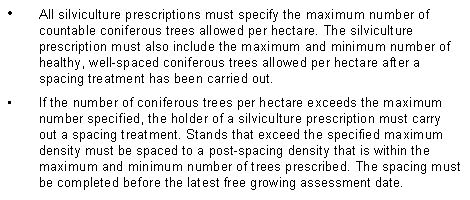
Setting density levels
The standards for maximum density for all conifers are generally uniform for the province. This is done to provide a consistent approach (equal treatment and obligations) to both industry and the Small Business Forest Enterprise Program, and across district and regional boundaries.
Different maximum density standards for different management units: Management unit-specific deviations for maximum density standards may be considered where there are specific forest habitat, forest health objectives, or target forest conditions approved in a TSA or TFL management plan. Different maximum density and minimum countable heights may be proposed on a management unit basis.
For example, a coastal TSA or TFL mangement plan has timber supply analysis units that assume that viable harvests occur when a minimum average stand diameter of 40 cm dbh and 400 m3/ha are achieved. The management plan yield curves assume that regenerating stands are grown at a density of no more than 1000 sph.
In the above example, density numbers may be proposed to require mandatory spacing when regenerating stand densities are too high to attain the desired stand conditions by the planned harvest date. Choose the maximum density number by analyzing the impact of increasing stand density on the time to achieve the desired stand conditions. The harvest age for a stand at maximum density should be about ten years more than a stand at target stocking.
Different maximum density may be proposed based on timber supply analysis units, management objective, species, site index, and management plan yield curve assumptions.
Proposals for change must be submitted to the chief forester for approval. No further approval is necessary for the specific changes to maximum density standards listed in this guidebook (see guidelines 4 and 9 for the CWH zone and guidelines 7 and 8 for wildlife habitat).
For areas that do not have approved management unit maximum density standards, the following standards apply:
Guideline 2

Trees must have a minimum height (see guideline 3) to be counted in a maximum density tally during a free growing survey.
Guideline 3
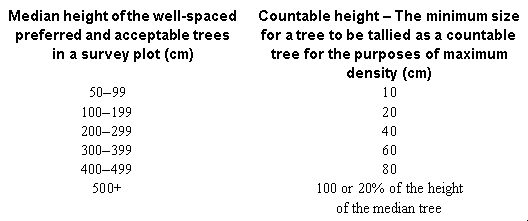
Guideline 4

Fulfilment of specific objectives may require stocking standards other than those listed in the Establishment to Free Growing Guidebook. Variations to the guidebook free growing stocking standards (target and minimum stocking standard) in a silviculture prescription will normally be reflected as changes to the maximum and minimum post-spacing densities.
The maximum post-spacing density may differ from the target stocking standard in a silviculture prescription if there are forest health, special wildlife habitat, integrated resource management, cattle grazing, or other objectives or concerns for an area. This is done at the silviculture prescription preparation stage. This variation is normally less than 600 well-spaced trees per hectare above the target stocking standard. The prescribed minimum number of well-spaced trees to be left after spacing should normally not be less than the minimum stocking standard.
Guideline 5

Guideline 6

For uneven-aged single tree selection systems that exceed the maximum density, spacing must be done on at least the layer 3 trees (between 1.3 m in height and 7.4 cm in diameter) to reduce the density to within the post-spacing density range.
For many of the larger mammals, there are approved guidelines for stand densities that should be established to maintain critical wildlife habitat. When field staff are setting up stocking standards for critical wildlife habitat, including maximum density and allowable post-spacing density ranges, the approved guides should be consulted to determine appropriate densities.
The following are guidelines for setting maximum density numbers for special wildlife habitat management objectives.
Guideline 7
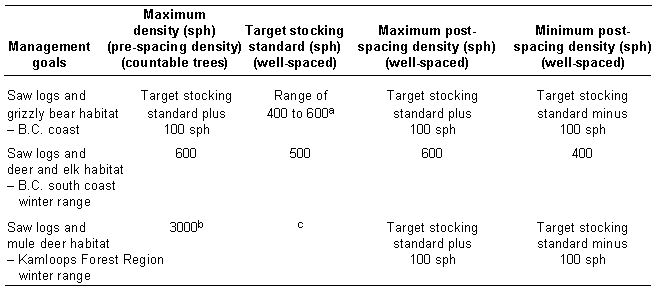
Management for mule deer habitat in the Kamloops Forest Region is listed in both guidelines 7 and 8. For both the even- and uneven-aged management at least 40 per cent of the area should be spaced to a target equal to the minimum stocking standard listed in the Establishment to Free Growing Guidebook. This more open stand should allow development of the necessary crown morphology for snow interception. The remainder of the area, after accounting for non-spaced zones such as buffers and wildlife tree reserves, should have a target stocking standard as listed in the Establishment to Free Growing Guidebook. This variability in spacing densities can be managed either within each block or proportionately distributed among a number of small blocks. These blocks should be within the same vicinity, such as a drainage, or they may be a number of blocks managed within one spacing contract.
Guideline 8 shows stand densities for mule deer winter range in the Kamloops Forest Region for uneven-aged single tree selection systems. The maximum density is inversely related to the canopy closure of both the overstorey and pole layer. Stands with dense upper canopies will have a low maximum density number for layer 3. The goal is to keep overall canopy closure low enough to allow growth of forage species.
Guideline 8
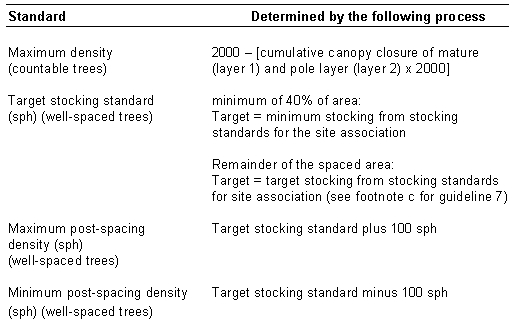
Salal-cedar hemlock sites
Maximum density may be modified for the salal phase of certain Coastal Western Hemlock (CWH) subzones, variants, and site series. Growth of the trees in these stands can be slowed excessively by salal. The current strategy for dealing with these sites is to ensure stands achieve crown closure as quickly as possible. This is accomplished by prescribing and leaving high stand densities. The salal dominance will be suppressed due to shading at crown closure.
Site preparation by broadcast burning, prompt planting, and fertilization at a very young age are techniques that may speed the attainment of crown closure. Suppression of the salal growth is not expected to occur until the stand has passed the optimum time for spacing.
The Forest Practices Code of British Columbia Act states that a maximum density number must be set. This requirement must be met while still allowing the necessary high stand density to suppress the salal on these sites. To accomplish this, maximum density can be set up to 10 000 countable trees per hectare for cedar/hemlock salal sites.
Guideline 9
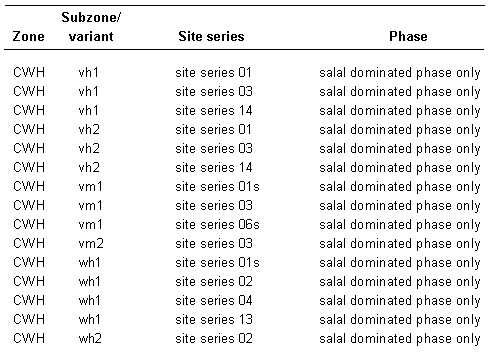
Sites can be designated as having a salal dominated phase when:
- 75 per cent of the site is covered by salal
- the stand is late immature or older
- the salal is not growing on a decaying substrate (i.e., the salal is growing on mineral soil or the forest floor).
To continue to achieve the objectives of early crown closure, the maximum and minimum post-spacing density should be set higher than normally prescribed. For these salal dominated ecosystems, a suggested maximum post-spacing density is 3000 sph. A suggested minimum post-spacing density is 2000 sph.
District and licensee staff should evaluate the current minimum and target stocking standards of 500 and 900 well-spaced trees/ha for these ecosystems. The evaluation is done to determine if the stocking standards will meet the objective of high establishment densities on these special ecosystems. Consider increasing the target stocking standards to 1500–2000 or more well-spaced trees per hectare, where high densities are desirable to achieve early crown closure. The minimum stocking standards should also be increased to 1000–1200 or more well-spaced trees per hectare.
These ecosystems often respond well to fertilization at time of planting or shortly after stand establishment. On appropriate salal dominated sites, fertilization may be included in a silviculture prescription and considered a basic silviculture obligation. See the Forest Fertilization Guidebook.
District and licensee staff should determine if modification of the earliest and latest free growing assessment dates is necessary for these ecosystems. When free growing surveys are carried out on these sites, the minimum countable height for a tree to be tallied should be 50 per cent of the median height of the preferred and acceptable well-spaced trees.
Earliest and latest free growing dates
The earliest and latest dates for the free growing survey in relation to the maximum density requirement will normally be the same as identified in the Establishment to Free Growing Guidebook.
For some tree species and ecosystems, trees in densely regenerated stands may take longer to reach a preferred spacing height. Foresters may wish to specify earliest and latest free growing dates in a silviculture prescription that are different than those specified in the Establishment to Free Growing Guidebook. The earliest and latest free growing dates can be lengthened to cover a time period when coniferous trees would achieve a desirable spacing height and to allow for more suitable selection of crop trees during spacing.
After spacing has been completed, no delay is required before a free growing survey is done. The silviculture prescription obligations can be declared as being met once a free growing survey and report indicates that the prescribed post spacing densities and standards for the site have been achieved. The sampling can be a low intensity survey and/or a visual assessment. This can be accomplished with the post-spacing inspection as long as sufficient information is obtained to fulfil Major Licensee Silviculture Information System (MLSIS) reporting requirements for major licence obligations and Integrated Silviculture Information System (ISIS) reporting requirements for the Small Business Forest Enterprise Program. The sampling methodology for maximum density obligations is outlined in the Silviculture Surveys Guidebook.
Amendments for forest health concerns
Forest health concerns should normally be dealt with at the pre-harvest stage. However, during the life of the obligations a forest health concern may arise. Surveys may indicate incidence of root disease or other forest health agents on a site. Treatment modification, no treatment, or application of a forest health strategy, may be necessary if the incidence exceeds threshold levels (see the section "Forest health factors"). Where a survey indicates that spacing may increase the forest health agent incidence on an obligation area, the holder of a silviculture prescription may apply to the district manager for:
- modifications to the maximum and minimum numbers of trees to be left after a spacing treatment
- exemption from the maximum density requirements for the portion of the obligation area that is affected by the forest health agent
- exemption from all maximum density requirements for the entire obligation area.
Where the holder of a silviculture prescription wishes to deviate from the approved prescription, they must prepare a silviculture prescription amendment and submit it for the district manager’s approval.
Implementing maximum density spacing
Spacing projects that are required to meet maximum density obligations do not significantly differ in implementation from an incremental silviculture spacing project (spacing project covered by a stand management prescription). Unspaced buffer strips or patches should be left, when necessary, to fulfil objectives such as hiding cover for wildlife (see the section "Maintaining stand level biodiversity"), or reduction of fire hazard (see the section "Fire protection"). The cumulative area of these buffers should normally not exceed 10 per cent of the standards unit area. The provision of these buffers is in keeping with the intent of the Forest Practices Code. Wildlife and biological diversity are listed as objectives in Part 2, Section 2(1)(a) of the Forest Practices Code of British Columbia Act.
The following sections of this guidebook are applicable to both maximum density and incremental silviculture spacing: "Fire protection," "Maintaining stand level biodiversity," "Considerations for post-treatment densities," "Methods of spacing," "Crop tree selection," and "Monitoring and reporting."
Guidelines for including spacing in stand management prescriptions
Spacing may be done on free growing stands, or stands that do not have a basic silviculture obligation, to meet landscape level objectives. The stand level objectives for a spacing treatment are chosen considering a particular stand’s site conditions, health and biodiversity, and its potential to meet landscape and integrated resource management objectives. Stand level objectives should be consistent with the landscape level objectives.
The following is a list of factors that should be evaluated before including spacing in a stand management prescription.
These criteria are presented to provide general guidance for preliminary evaluation and ranking of stands. Appendix 1 lists the ranking criteria and considerations for use in the development of stand management prescriptions.
Biological criteria
Guideline 10

Consider biological factors when evaluating/ranking stands for spacing. These factors are:
- species
- site quality
- stand density
- height
- age
- forest health factors.
Species
Species that have high wood values and have good response to spacing should be given treatment priority. Examples on the Coast are Douglas-fir and hemlock stands, which capture high market values and show good response to spacing. In the Interior, lodgepole pine can be severely overstocked and individual trees respond rapidly to thinning, particularly in the early years. Douglas-fir in dry Interior areas often grows as a suppressed overstocked understorey and responds well to spacing.
Site quality
The growth response to spacing depends on the site quality. In general, trees on good sites show more response than trees on poor sites. Good sites should therefore receive highest priority for spacing. Spacing of pre-October 1, 1987 dense lodgepole pine stands (>10 000 stems per ha) on poor sites in the Interior can be done to avoid repression of height growth.
Stand density
Spacing stands with high initial densities can result in a large individual tree growth response. High density stands should be given a priority for spacing as long as the treatment can be done before competition becomes too severe. Factors such as per cent live crown and height/diameter ratio will indicate the amount of competition occurring in a stand.
Per cent live crown: The per cent live crown is related to the degree of crowding or competition and is a good indicator of a tree’s capability to respond. Per cent live crown is the ratio of live crown length to total tree height. When estimating live crown length, small or isolated lower branches below the main crown should be disregarded. In general, the per cent live crown of a crop tree is likely to diminish in older and denser stands, resulting in a decreasing response to treatment. A 30 per cent or less live crown for crop trees generally indicates a tree that has had significant competition.
It may be acceptable to space very dense lodgepole pine stands (>10 000 sph) with residual live crowns less than 30 per cent. Spacing of such stands may reverse height repression and is therefore a priority, providing that the treatment is done on young stands.
Height/diameter ratio: The height/diameter ratio is measured by dividing the tree height by the stem diameter at breast height with height and diameter in the same units (e.g., centimetres). This ratio changes with the degree of competition over time. At a given height, trees that have been crowded will not have as large a diameter as trees that have not been crowded. The crowded trees will therefore have a higher height/diameter ratio. Height/diameter ratios are indicative of a tree’s ability to withstand wind and snow and ice loading. Concerns should be raised when ratios are above 90.
Height and age of stands
It is preferable to space shorter stands to avoid high treatment costs, to minimize slash management problems and to avoid growth loss due to the onset of competition.
The stand’s ability to respond to spacing is partially a function of the stand’s age. Younger stands should be given higher priority due to their ability to respond more favorably to treatment. However, stands should be old enough that crown lift has begun (to avoid problems of live branches on stumps), and significant ingress is complete.
Forest health factors
Forest health factors include insects, disease, wildlife, and abiotic conditions. Consult the silviculture prescription for information on damaging agents that may be problematic due to spacing. The prescription may also contain recommendations on spacing techniques and timing that could affect forest health factors or their impact. Information on forest health factors following stand regeneration is collected through silviculture or pre-stand tending surveys and is stored in data bases such as the Integrated Silviculture Information System.
The type and degree of damage predicted for a particular pest will determine if, when, and how a stand should be spaced. Spacing can increase or decrease risk of further damage. Some general precautions should be taken to determine whether spacing may assist in control or may leave the stand susceptible to infestations. If a silviculture survey of the stand has not been completed recently, complete one before spacing. Use the survey results and any other information, such as the Forest Health Charts in the Establishment to Free Growing Guidebook, to identify any potential problems that may confound stand spacing.
Results from the silviculture survey or other initial forest health assessment may indicate the need for additional forest health surveys.
Forest health survey results should be used, if necessary, to stratify the area into different treatment units. Stratification may be necessary if areas covered under the silviculture prescription or stand management prescription have different levels of infestation, triggering different treatments or no treatment in a portion of the block.
Threshold levels are developed for a variety of forest health factors. Details on these thresholds and related surveys are presented in the various forest health guidebooks and the Silviculture Surveys Guidebook.
Diseases
Root disease: Control of root disease should have occurred at the prescription and stand regeneration stage. If this has occurred successfully there should not be any further root disease problems for spacing. If however, a current silviculture survey shows one to five per cent of host species infected with armillaria or phellinus, or any presence of tomentosus infection, consult the Root Disease Guidebook for further direction. Treatment strategies vary depending on the specific root disease. Strategies outlined in this guide are:
- inoculum removal by pop-up spacing
- alternate species selection
- favoring less susceptible species
- bridge tree removal.
Dwarf mistletoes: Any residual, overtopping dwarf mistletoe-infected tree that jeopardizes the health of young trees should, if possible, be removed. The prescription or forest district staff should be consulted to determine why the residual trees were retained at the time of harvesting, before a recommendation is made to remove them.
Once overtopping infection sources are removed, free growing trees should out-grow the dwarf mistletoe infections. Consider removing infected trees during spacing. Refer to the Dwarf Mistletoe Guidebook.
Comandra blister rust, stalactiform blister rust and western gall rust: A tree is considered infected if:
- for comandra or stalactiform, the rust is found anywhere on the stem or on a branch closer than 60 centimetres from the bole
- for western gall rust, the rust is found anywhere on the stem or on a branch closer than 10 centimetres from the bole.
Disease incidence and recommended treatment tactics for all three rusts on lodgepole pine:
White pine blister rust: Rust-free western white pine should be retained wherever it is found. This is done to increase biodiversity and on the possibility that the retained tree may exhibit signs of genetic resistance to the rust. For western white pine to be considered a potential crop tree, it must normally be pruned as a treatment for white pine blister rust.
Spacing has been shown to increase white pine blister rust infection rates through increased spore movement through the thinned stand. It is therefore recommended that white pine trees that are of suitable size and are free from stem infection be pruned at the time of the spacing treatment. This is particularly important where the retention of white pine is necessary to meet stand level objectives.
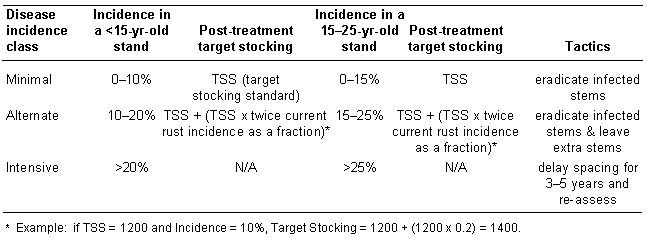
Insects
Defoliators: Consult the forest district regarding the current phase and outbreak cycle (periodicity) of particular defoliator species. When current or predicted defoliation (in the coming year) is moderate or greater, spacing should only be prescribed in conjunction with direct control programs for the particular defoliator (see Defoliator Guidebook).
Bark beetles (in partial cutting silvicultural systems)
Douglas-fir beetle: Ensure that spacing slash is less than 10 cm diameter. All spacing slash of a diameter greater than this must be removed or destroyed when Douglas-fir beetle is present in the stand or area.
Mountain pine beetle: Spacing should be done in conjunction with sanitation treatment of the stand. Residual stems must not be damaged during the spacing or sanitation process.
Review the Bark Beetle Management Guidebook and consult forest district staff.
Spruce and lodgepole pine terminal weevils
Spacing should not be conducted in high risk stands, or stands where weevil damage is occurring or expected, until the incidence of the damage is clearly declining. An attack threshold related to spacing for lodgepole pine terminal weevil is 10 per cent. Conduct surveys of weevil damage incidence according to procedures described in the Terminal Weevils Guidebook. Weevil damage incidence should not be estimated in stands <15 years old. Surveys conducted in five-year intervals should allow a determination of a declining population. Weevil attack may delay spacing for periods of 5–10 years with lodgepole terminal weevil and up to 15–20 years with spruce weevil following the completion of the free growing survey.
Other insects
Consult regional guidelines, or discuss the issue with forest service regional and district staff.
Wildlife
Treatment thresholds related to spacing lodgepole pine have been established only for red squirrels. The decision-making profile for squirrel damage is presented in the Pests of Young Stands Guidebook. For other wildlife damage problems, contact forest service regional or district staff.
Operational considerations
Operational factors such as project and block size, access, and slope affect costs, and should therefore be individually considered.
Factors affecting costs of spacing projects:
- Post-spacing slash height – if a maximum slash height is set for fire hazard reasons, additional cutting may be necessary to reduce slash height.
- Access to and within the block – the cost of improving access should be weighed against the benefit of reducing the travel time to the work site.
- Stand density and height prior to spacing – the number of stems to be cut and the ease or difficulty of cutting them and getting them on the ground will impact costs. Live limbs right to ground level may increase costs.
- Trafficability – pre-treatment slash loading, slope, wide and low crowns, and brush can affect worker movement within the block.
- Worker availability – prices can be affected by the supply of workers. For example, prices can be higher in communities with a small work force, or with attempts to get projects accomplished at the end of the field season. In the Interior, fall viewing of the next year’s projects generally leads to lower bids.
- Fire season – fire prevention regulations must be strictly applied in the fire season. This will normally entail a fire watch and extra equipment on site.
- Special contract requirements – for example, slash pull back zones.
Fire protection
Concentrations of slash resulting from spacing operations can present a fire hazard to the stands themselves and possibly to surrounding values. Natural events will diminish this hazard over time. In the meantime, it is prudent that forest managers be aware of the hazard and attempt to mitigate it. Silviculture prescriptions or stand management prescriptions must accurately prescribe the best treatment for the site that addresses all concerns, including fuel loading and long-term fuel management in the area.
The complete elimination of hazard is not practical or possible. These guidelines are intended to identify the factors that should be considered in determining an acceptable level of hazard and what considerations should be incorporated in stand management prescriptions or silviculture prescriptions.
Estimating fire hazard
The information from the FS 748, Pre-Stand Tending Survey, and the summary of these field cards on the FS 770 Pre-Stand Tending Site Description Prescription can be used to determine fire hazard and risk for a site scheduled for a spacing treatment.
- Low hazard – less than 10 per cent of the original stand density will be felled
- Moderate hazard – 10 to 30 per cent of the original stand density will be felled
- High hazard – greater than 30 per cent of the original stand density will be felled.
Most, if not all, sites will be moderate or high hazard and therefore strategies must be prepared for managing fuel levels on the area (Forest Fire Prevention and Suppression Regulation).
The following site-specific factors should be considered when determining the amount of risk inherent in a site and the potential strategies to, if necessary, reduce this risk:
- Location: Proximity to people or other resource values, biogeoclimatic zone, degree of isolation, proximity to unabated hazards.
- Access: Ease of access, amount of travel in area, existing or future deactivation.
- Slope: Steeper slopes increase the rate of fire spread.
- Aspect: South and West slopes are generally more hazardous.
- Block size: Larger openings create more contiguous slash.
- Fuel loading: Amount of slash increases with the size of the stems and as more stems are felled. Depth of slash can be influenced by falling pattern.
- Species: Combustibility and fire intensity is impacted by tree species. In reducing order of combustibility: cedar, pine, fir, spruce/balsam, hemlock, and deciduous.
- Time: Slash loading reduces over time; the rate of decay varies by site parameters listed above.
Guideline 11

Strategies to reduce fire risk
When reviewing the options, the benefits of hazard reduction must be weighed against the costs. Some costs are minimal and easily incorporated while others are significantly higher to minimize hazard. Not all costs are necessarily direct contract costs. By foregoing or rescheduling treatments, there may well be opportunity costs to stands or portions of stands in terms of stand growth foregone. Refer to the Fire Management Guidebook for additional information. The aim is to achieve an acceptable standard of hazard reduction by using combinations of fuel modification, risk reduction and prevention strategies. Consider the following factors when developing a strategy to reduce the amount of risk created and the duration of the risk.
- Access restriction: Deactivation or temporary road closures.
- Prevention: Signs, forest closures, campfire bans or increased patrols.
- Block size: Size of openings can be limited where applicable.
- Buffer strips: Unspaced strips can be left along roads. The need for and width of the strip would vary depending on the severity of the hazard and the amount the road is used. Widths could vary from 5 to 20 metres. The strip is usually measured from the edge of the road running surface. Use roadside features such as cutbanks as natural buffers where possible.
- Roadside fuel reduction: Slash can be pulled to road side and burned or chipped. Slash can be pulled into the block. The width of the strips varies from 0 to 20 metres measured from the edge of the road running surface.
- Fuel modified in block:
- Lop and scatter to reduce fuel depths. Slash depth should be measured from the ground to the stem. This is an important cost item in heavy slash and specifications should not be unreasonable. A reasonable target may be an average one metre slash depth.
- Under burning or burning of slash during low hazard.
- Directional falling within the block to reduce fuel depths.
- Directional falling into the block at the block perimeters. Falling into the block will reduce the amount of fine fuels near roads and adjoining areas.
- Utilization of some of the slash during low fire danger (e.g., for firewood or post and rails).
No spacing permitted: Risk may be so great that the stand should not be spaced.
No restrictions: Risk may be so low that no special measures are required.
Guideline 12

Some circumstances may require that greater than 500 hectares be disturbed or treated. Examples of such cases are large fires with dense natural regeneration that require spacing, or drainages that must be treated before access is removed. If the 500-hectare recommended limit is exceeded, the strategy for reducing risk must reflect this.
The Fire Management Guidebook defines fire resistance areas. For the purposes of spacing, there should be a minimum of 5 years since spacing and the trees should be a minimum of 5 metres tall.
Guideline 13

Maintaining stand level biodiversity
Landscape level biodiversity objectives should be considered and incorporated into silviculture prescription or stand management prescription objectives. Stand level practices are carried out to maintain or promote a component of the historic levels of stand attributes. Prescriptions should address the management of stand attributes and timber production during the entire rotation. Some wildlife species may require consideration beyond the usual habitat features considered at the stand level. Individual species management may take precedence over the standard stand level procedures for maintaining biodiversity during spacing. Specific considerations for biodiversity should be clearly referenced in spacing contracts. Refer to the Managing Identified Wildlife Guidebook and Guidelines for Maintaining Biodiversity During Juvenile Spacing for additional information.
Species management
Critical habitats are those of identified wildlife (see the Managing Identified Wildlife Guidebook) as well as ungulate winter ranges and habitats of species of regional significance. Such areas may be designated wildlife habitat areas (WHA). Specific provisions for maintaining wildlife habitat areas or other significant habitats should be included in sub-regional, landscape, and stand-level plans.
Guideline 14
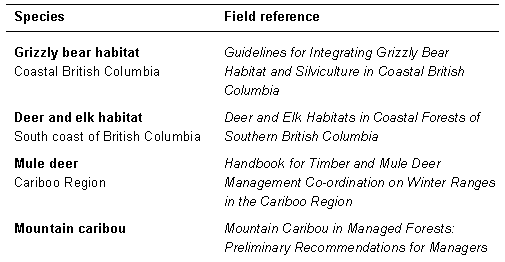
Where special management or emphasis areas have been identified, and the existing guidelines or the Managing Identified Wildlife Guidebook do not provide sufficient information or guidance, contact the Ministry of Environment, Lands and Parks staff or regional forest habitat specialist.
Stand level management to maintain biodiversity
Wildlife trees, vertical and horizontal structural variability, and the maintenance of native tree composition are important features to address when planning for stand level biodiversity in a spacing operation. Stand structure and composition objectives should be identified at the landscape unit level. Consider these features when developing silviculture prescriptions, stand management prescriptions, and contracts, and when implementing stand activities. Figure 2 shows an example of a spaced stand with biodiversity attributes maintained. Refer to the Biodiversity Guidebook, and Guidelines for Maintaining Biodiversity During Juvenile Spacing.
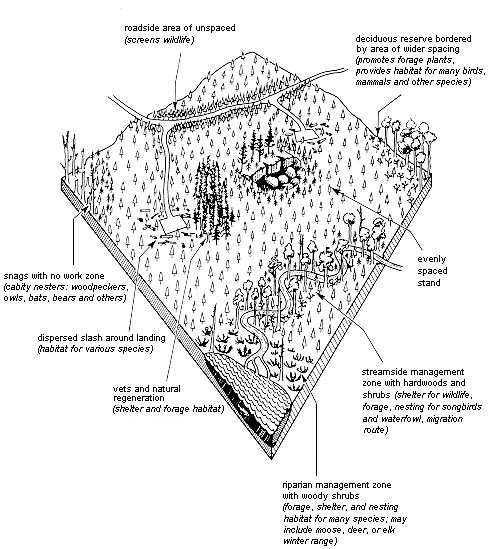
Non-competitors
The Silviculture Practices Regulation states that a tree which is not a significant competitor with a crop tree should not be felled in a spacing treatment.
A tree is not a significant competitor with a final crop tree when it is one or more of the following:
- below the minimum cutting height specified in a spacing contract.
- designated as a tree that should not be cut (ghost tree), as specified in the silviculture prescription, stand management prescription, or a spacing contract (e.g., western white pine, or western yew).
not a preferred or acceptable species and
– not within the minimum inter-tree distance from a superior leave tree or crop tree or
– is not overtopping a superior leave tree or crop tree and will not likely do so in the future.
Wildlife trees
A wildlife tree is a standing dead or live tree with special characteristics that provide valuable habitat for conservation or enhancement of wildlife.
Wildlife tree management includes both the retention of suitable wildlife trees at the time of harvest and silvicultural activities, and the recruitment of suitable replacement wildlife trees over the rotation period.
Generally, the safest and most operationally feasible method for managing wildlife trees is to leave a mixture of live and dead standing trees in a clumped distribution (reserves). The location and size of the reserves in a stand will depend on specific site conditions such as availability of high value wildlife trees, and wind firmness. The amount of wildlife tree area required for any specific unit depends on the level and distribution of existing and planned harvesting on the surrounding landscape. Areas to consider for wildlife tree reserves may include the edge of the stand, areas that are difficult to access, or less productive areas. This location can be chosen to minimize the impact of the mandatory no-work zone. Where possible wildlife tree reserves and no treatment zones should be described in a stand management prescription and identified on an accompanying map. Refer to the Biodiversity Guidebook for more information on wildlife trees.
Guideline 15

Variable stocking levels
Maintaining a variety of stocking levels will provide for vertical and structural variability in the stand. Both unthinned areas and areas of wider spacing should be used to provide variability. Wide spacing in 2 to 8 ha patches could be used to promote understorey vegetation. Significant areas of varied density may need to become a separate standards unit in a silviculture prescription or stand management prescription.
Unthinned areas may be necessary for security cover and thermal cover for wildlife. Such areas provide physical concealment from hunters and predators. Some wildlife, such as deer, prefer to be near cover at all times. Provision of cover close to forage and water increases the utility of these resources.
A visual buffer, also known as a visual screen, should exist along main and secondary roads in areas with high populations or hunting pressure of big game species. A visual buffer may be provided by topography or vegetation (Figure 3) that blocks the viewing of the interior of the treatment area. The buffer size depends on the specific site conditions. The width of the buffer should be sufficient that a person or animal walking along the interior edge of the buffer is at least 90 per cent screened from view from the road.
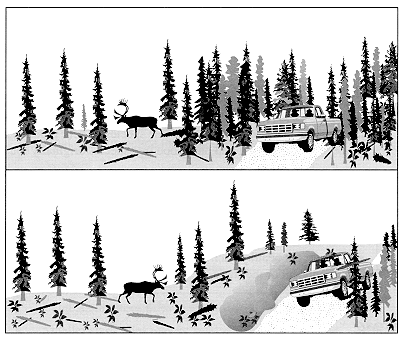
Leaving small patches or strips of unspaced trees may also be required to create hiding cover within the stand within the stand or around important wildlife areas such as wildlife trees and riparian zones.
Whenever possible, there should be multiple objectives for areas left unspaced. These objectives can include roadside visual buffers for wildlife, riparian area buffers, and buffers for reducing fire risk. However, roadside buffers along heavily travelled roads may not be appropriate for wildlife thermal cover.
Unspaced areas greater than 50 metres wide may be useful as treatment controls. Future retrospective comparisons of untreated areas to treated areas may be possible if the untreated area was originally homogeneous with the area being treated.
Guideline 16
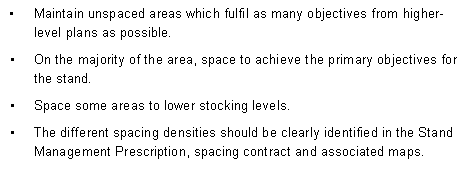
Maintaining understorey species composition
Understorey shrubs such as willow and elderberry provide forage for deer and moose, particularly in winter. Berry producing shrubs provide important forage for bears, some songbirds, and small mammals. Shrubs also provide shelter for a variety of birds, snowshoe hare, squirrels, chipmunks, and other small mammals. The full range of native understorey plants and plant communities should be maintained across the landscape unit.
Guideline 17

Maintaining native trees composition
A stand with several tree species will tend to support more species of animals than a stand that contains only one tree species. Where possible maintain the full range of native conifer and hardwood tree species originally found in the stand.
Guideline 18

Riparian areas
Riparian areas will often require special management. Willows, red-osier dogwood, and other shrub species provide important winter forage for moose and deer. Riparian areas provide feeding and nesting grounds for many varieties of wildlife. Waterside vegetation will help lower water temperature, and fallen trees can create important habitat diversity for fish and other aquatic organisms. Refer to the Riparian Management Area Guidebook for additional information.
Guideline 19

Wildlife trails
Wildlife trails may be permanent or temporary. Grizzly and black bear make well defined, permanent trails used for travel and as home range markers. Moose, deer, and elk may also make permanent trails that follow less difficult lines of travel—for instance, along ridge tops or through drier areas in swamps.
Slash
Large wildlife experience difficulty in moving through stands with large continuous piles of slash. By spacing stands when trees are younger, large accumulations of slash may be avoided. If large, continuous slash piles are unavoidable, the creation of gaps through the slash may facilitate wildlife movement.
Directional falling allows the cut trees to lie flatter on the ground, allowing easier access through the stand. With the slash closer to the ground, it reduces the fire hazard and decomposes faster. Areas identified as winter range may require additional work to reduce the slash depth to an acceptable level.
Slash should be removed from water bodies (streams, rivers and lakes) and wildlife trails. The slash can be redistributed through the stand or placed in small piles. Small slash piles provide potential shelter habitat for birds and mammals. Ideally, such slash piles should consist of a few very large stems. Where forage production is an objective, consider selective piling of slash and burning.
Guideline 20

Not all desirable habitat features will be present in any one stand. At a minimum, each stand will be managed for its existing attributes, or the attributes that can be created at each stage in its development. In some stands, less emphasis may be placed on maintaining biodiversity if:
- the existing stand structure limits options to promote biodiversity
- the surrounding forest contains a diversity of habitats, and is already being managed to maintain those habitats
- access, terrain, or other factors render some biodiversity management techniques impractical.
Considerations for post-treatment densities
The following are several factors that should be considered when prescribing post-spacing densities in a stand management prescription.
Forest health factors
Where levels of pest attack are low and guidelines recommend spacing (see "Forest health factors" in the section on "Spacing for stand management prescriptions"), extra stems should not normally be left to counteract the impact of a low incidence of a damaging agent. There are several specific exceptions to this general recommendation:
- comandra blister, stalactiform blister, and western gall rusts (see "Forest health factors" in the section on "Spacing for stand management prescriptions" and the Pine Stem Rust Guidebook)
- lodgepole terminal, spruce, and Warren’s collar weevils (see the Terminal Weevils Guidebook).
For all other forest health factors, the loss in merchantable yield and value due to higher stand densities is likely to outweigh the attack damage.
Site quality
The effects of site quality is sometimes a consideration in prescribing post-spacing densities. At a given stand density, both height and diameter growth are generally lower on a poor versus a better site. Where wood flow problems are a consideration, a density lower than what would otherwise be prescribed on a better site, will lead to a shorter technical rotation. However, the lower residual densities on poorer sites generally have the following trade-offs:
- lower merchantable volumes at the technical rotation
- larger average diameters
- more taper
- larger branches/knots, more juvenile wood content.
Target stand conditions
Post-treatment density levels must be determined based upon the target stand conditions desired for the stand. The objectives are normally stated in the silviculture prescription or the stand management prescription. An objective for a stand may be attainment of a target diameter sawlog and minimum volume within a rotation of a specified number of years. This objective is set considering the site quality of the stand. It will take longer to attain a target average stand diameter from a low site quality stand than a high site quality stand at the same stand density. The post-treatment density must be set so that the objective can be met. Refer to managed stand yield tables or growth models to determine appropriate leave tree densities to achieve desired stand structure objectives.
Wildlife habitat
Post-treatment densities will impact the type of wildlife habitat the area will provide. If the area is designated as significant for wildlife habitat refer to the sections "Setting density levels" and "Species management."
Range
If cattle management is identified in a range resource plan as an important resource on the site, densities may be kept low for growth of forage. Spacing of areas where cattle graze will require measures to protect the range resource. Existing cattle trails should be kept clear of slash accumulations to ensure continued cattle access. Fences should be cleared of slash accumulations for two metres on each side to provide access. Stumps throughout the area should be cut as low as practical (i.e., 20 cm high) and as flat as practical (i.e., stump angle not exceeding 1:2 rise/run) to reduce the risk of injury to cattle and range riders. Accumulations of heavy slash should be avoided so that cattle, particularly calves, can use the area without getting trapped by slash accumulations. The impact of heavy slash can be reduced by directional falling, limbing, bucking, and cutting access trails.
Guideline 21

Future treatments
Commercial thinning
If commercial thinning is planned, more stems may need to be left on site. If, for example, 500 Douglas-fir stems/ha would be left with no commercial thinning planned, then 800 to 1100 stems/ha after spacing may be appropriate where a subsequent commercial thinning is planned.
There should be a commitment to perform the planned commercial thinning. Stand objectives cannot be met without the thinning entry once additional stems have been left. Confirm if a planned commercial thinning is necessary to meet higher-level objectives before prescribing higher stand densities. See the Commercial Thinning Guidebook.
Guideline 22

Pruning and fertilization
Stands identified for pruning or fertilization should be at, or spaced to, proper stocking. The residual stand densities for fertilization must be low enough to allow room for crown expansion after treatment. Stand densities for pruning must be low enough to allow maximum growth of the pruned trees in order to obtain the optimum financial benefit. If required, spacing should occur before or in conjunction with fertilization or pruning to optimize treatment impacts and minimize treatment costs.
If pruning is planned, lower densities are more appropriate. For example, the best economic returns for coastal Douglas-fir (good and medium sites) occur when 400 to 500 sph are pruned. See the Pruning Guidebook and the Forest Fertilization Guidebook.
Guideline 23

Methods of spacing
Methods used for spacing may be:
- manual, using a wide range of tools including long-handle shears, chain saws, and brush saws
- chemical, (rarely used in B.C.) applications to individual trees through hack-and-squirt or lance injectors
- mechanized chopping, mulching, brushing, or slashing.
The equipment selected is based on the pre-spacing density, size of trees, terrain, and the amount of slash and brush on the site.
Manual
Manual treatments utilize a wide assortment of tools ranging from inexpensive shears to costly brush cutters. Although some tools only require minimum worker skills, experienced well-trained workers will ensure efficiency and worker safety during spacing operations.
Mechanized
Mechanized equipment has been developed to improve the economics of spacing in dense immature stands. The majority of equipment uses non-selective, strip thinning where standing material is destroyed in alternating cut and leave strips. The leave strips must then be spaced manually. The manual treatment may be delayed 1–3 years after strip thinning. This delay will allow damage caused by the machines or windthrow to become obvious. The cost of this manual spacing must be counted in the total cost when assessing this treatment. Wait until the live crown has lifted at least one whorl above the ground before doing any strip thinning. Strip thinning of stands with full live crowns will likely leave live branches after the treatment.
Several machines have also been developed to do selective spacing where the operator determines the suitable crop trees based on spacing distance and tree characteristics. A B.C. trial using the Silvana Selective showed that, for the machine to be a cost-effective alternative to chainsaws, the stand should have more than 25,000 sph and relatively flat terrain.
Pop-up spacing is a technique designed for use on sites with root disease. This technique breaks up root contact and inhibits the ability of the fungus to spread.
Mechanized equipment may be restricted by site conditions. Efficient operation requires large treatment areas with gentle terrain, preferably minimal site debris and soil conditions suitable for use of heavy equipment. The amount of detrimental soil disturbance should be close to zero. Cumulative detrimental soil disturbance over a complete rotation must not exceed that listed in the Soil Conservation Guidebook.
Guideline 24

Mechanized operations are often well suited for remote areas and areas where there is a shortage of field workers.
Crop tree selection
Crop tree selection is critical to maintaining stand health and vigor by the selection of the healthiest, best formed, and fastest growing trees in the stand. A stand management prescription will specify the species, densities, and conditions of trees to be left after spacing. Trees left after spacing should combine as many of the following characteristics as possible:
a. preferred species
b. dominant or co-dominant tree
c. free of injury and disease
d. full crown
e. straight stem
f. free from forks or multiple top
g. small branches
h. good terminal growth
i. good color
j. growing on a good microsite.
In addition, the following general guidelines regarding tree removal or retention should normally be adhered to:
- Single trees within openings should be left, although they might not otherwise qualify as crop trees.
- The spacing on the edge of openings should be reduced to one half the specified distance to compensate for trees missing from the opening. The number of additional trees left should be no more than the number of trees that the opening could accommodate at the target inter-tree distance.
- Forked or double-topped trees should preferably be cut. However, if selected to leave, they should be left wholly uncut.
- All trees not selected as leave trees should be removed if they are taller than a minimum height (e.g., 0.5 m, 1.0 m).
- Selection of superior crop trees should usually supersede strict adherence to the specified spacing interval.
- In multi-storied, mixed conifer stands, size will normally take priority over species preference in crop tree selection, particularly where the size difference is substantial (e.g., 3 m).
- Do not retain an overly dense stand in one spot to compensate for a shortage of trees in another.
Monitoring and reporting
Monitoring
A spaced area may be monitored for compliance with standards set out in the stand management prescription or silviculture prescription. The B.C. Ministry of Forests may perform monitoring of spacing projects using the methodology described in the Ministry of Forests Silviculture Contract for Stand Tending – Juvenile Spacing, Schedule A (FS 751A). The minimum acceptable performance quality is 85 per cent. The main considerations are those listed in guideline 26.
Guideline 25

Ensure that the spacing reduces the number of stems per hectare to achieve the specified densities and minimum inter-tree distances. Make sure spacing projects are well managed so that spacers choose the best crop trees and leave the residual stand in good condition.
Guideline 26

Guideline 27

Reporting
Spacing done to fulfil requirements of a silviculture prescription for major licence holders must be reported quarterly in Form B to the district manager. Form D reports, describing silviculture expenditure for the preceding year, are due May 15. Spacing done to fulfil silviculture prescription obligations for a woodlot licence holder is annually reported on or before April 30 to the district manager. Spacing done to fulfil a silviculture prescription prepared by the Crown must be reported annually on or before April 30 (beginning in 1996) to the regional manager. Information for this report will be from the Ministry of Forests corporate data base.
The quarterly submission dates are April 15, July 31, October 31, and January 15.
Reporting of stand management prescription accomplishments on free growing stands is required for major licence holders. The Silviculture Practices Regulation requires that a treatment report is submitted quarterly to the district manager. This report must:
- include a summary of the silviculture treatments, including spacing, accomplished on specified areas. Spacing information should include dbh, height, total stems per hectare, and a location map.
- cover the period of two weeks before the last report date and ending two weeks before the current report’s submission date.
- be signed and sealed by a professional forester.
Guideline 28

Spacing on free growing stands done by the Small Business Forest Enterprise Program should be reported following ministry procedures.
Appendix 1 - Stand selection guidelines for use in stand management prescriptions
Biological criteria for ranking stands for spacing
The following guidelines are intended to help prescribers in evaluating and selecting appropriate sites and spacing treatments for stand management prescriptions. Ranking is from most desirable (1) to least desirable (3) with some sites or conditions ranked as not recommended for treatment (NR).
These guidelines are not intended for use on areas that have a legislated requirement for maximum density spacing. Standards and guidelines for maximum density spacing are included in the section "Spacing required by silviculture prescription" of this guidebook.
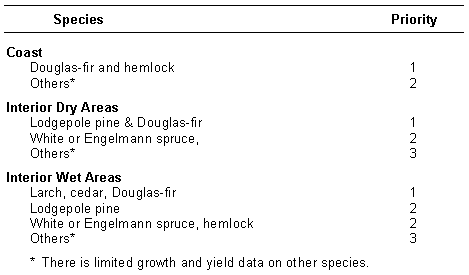
Appendix 2 - List of referenced guidebooks
- Bark Beetle Management Guidebook
- Biodiversity Guidebook
- Commercial Thinning Guidebook
- Defoliator Guidebook
- Dwarf Mistletoe Guidebook
- Establishment to Free Growing Guidebook
- Fire Management Guidebook
- Forest Fertilization Guidebook
- Forest Health Surveys Guidebook
- Managing Identified Wildlife Guidebook
- Pruning Guidebook
- Riparian Management Area Guidebook
- Root Disease Guidebook
- Silviculture Surveys Guidebook
- Soil Conservation Guidebook
- Stand Management Prescription Guidebook
